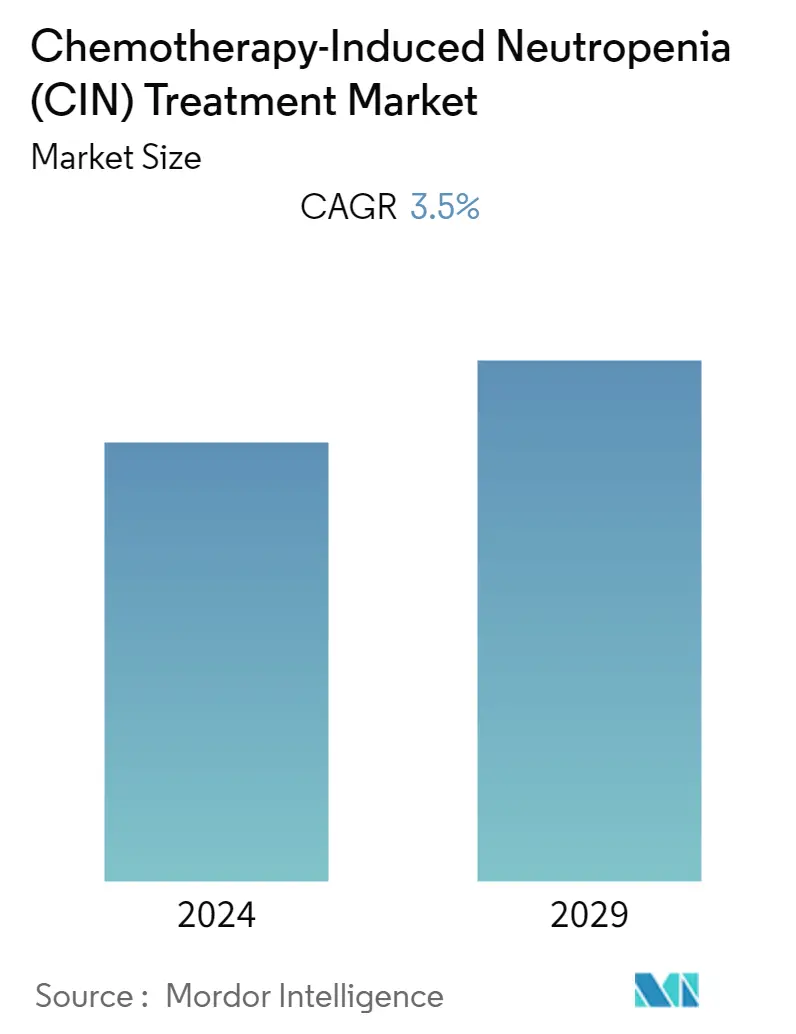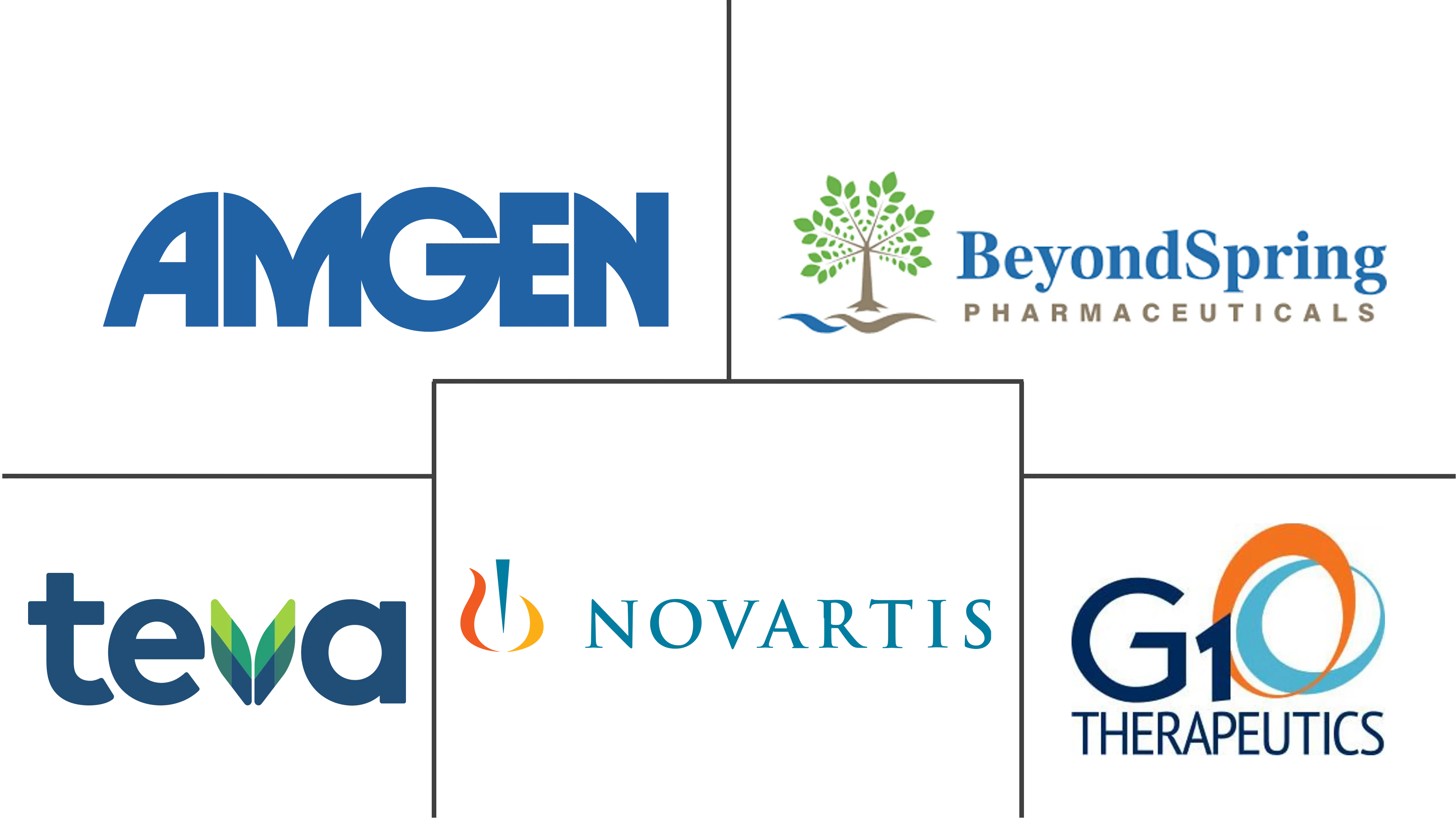Market Size of Chemotherapy-Induced Neutropenia (CIN) Treatment Industry

| Study Period | 2019 - 2029 |
| Base Year For Estimation | 2023 |
| CAGR | 3.50 % |
| Fastest Growing Market | Asia-Pacific |
| Largest Market | North America |
| Market Concentration | Medium |
Major Players
*Disclaimer: Major Players sorted in no particular order |
Need a report that reflects how COVID-19 has impacted this market and its growth?
Chemotherapy-Induced Neutropenia (CIN) Treatment Market Analysis
The chemotherapy-induced neutropenia (CIN) treatment size is estimated at USD XX million in 2023. It is expected to reach USD XX million by 2028, registering a CAGR of 3.5% during the forecast period.
The outbreak of COVID-19 impacted the chemotherapy-induced neutropenia (CIN) treatment market. The massive volume of COVID-19 patients and the lockdown disrupted the diagnosis and treatment of non-COVID-19 diseases such as cancer. The decrease in the number of cancers led to a decline in chemotherapy and chemotherapy-induced neutropenia, hampered the demand for chemotherapy-induced neutropenia treatment. For instance, a study published in the European Journal of Epidemiology in January 2023 stated that there had been a decline of over 27.0% in the volume of cancer diagnoses amid the pandemic globally. However, in the post-pandemic period, the volume of COVID-19 patients decreased, which led to the resumption of the diagnosis and treatment of other chronic diseases, such as cancer, and it enabled the market to grow normally. For instance, in February 2021, Tata Memorial Hospital in India reported that the normal count of cancer patients was resumed at the cancer OPD of the hospital after the pandemic. Thus, the pandemic imposed an adverse impact on the chemotherapy-induced neutropenia (CIN) treatment market initially; however, with the decrease in the number of COVID-19 cases, the resumption of the diagnosis and treatment of cancer and the increasing volume of chemotherapy-induced neutropenia (CIN) treatment, the market is growing at a normal pace. It is expected to continue the same over the forecast period.
The increasing prevalence of cancer, rising use of chemotherapy treatment, and increasing research and development activities are the major drivers for the market.
The rising prevalence of cancer and the increasing use of chemotherapy for its treatment has led to an increased use of chemotherapy-induced neutropenia in cancer patients. For instance, as per the American Cancer Society Colorectal Cancer Statistics in 2023, over 153,020 adults are estimated to be diagnosed with colorectal cancer 2023 in the United States. These numbers include 106,970 new cases of colon cancer and 46,050 new cases of rectal cancer in the United States. Furthermore, the data published by the Australian Institute of Health and Welfare in August 2022 stated that over 151,000 new cancer cases were estimated to be diagnosed in Australia in 2021. Thus, such a rising burden of cancer is expected to elevate the number of chemotherapy-induced neutropenia in cancer patients. Therefore, these factors will boost the treatment demand, driving the market growth over the forecast period.
Furthermore, many research studies have highlighted the high risk of developing neutropenia in chemotherapy patients. For instance, an article published in the eCancer Medical Science in February 2021 stated that during chemotherapy, one out of every three patients of breast cancer included in the study developed neutropenia while on chemotherapy. Thus, with the high burden of cancer and the high volume of chemotherapy, the number of chemotherapy-induced neutropenia is expected to increase, which in turn is expected to accelerate the demand for neutropenia treatment products, propelling the market growth.
Moreover, the recent developments by the market players are expected to increase the penetration of treatment products intended to manage chemotherapy-induced neutropenia. For instance, in March 2022, the U.S. FDA approved the Biologics License Application (BLA) of Amneals' filgrastim-ayow, a biosimilar referencing Neupogen used to treat chemotherapy-induced neutropenia. Further, in February 2021, G1 Therapeutics, Inc. received approval from the U.S. FDA for its therapy drug, COSELA (trilaciclib). The drug is intended to manage chemotherapy-induced myelosuppression in adult patients when administered before a platinum/etoposide-containing regimen or topotecan-containing regimen for extensive-stage small cell lung cancer (ES-SCLC).
Therefore, owing to the abovementioned factors, such as the increasing burden of cancer, the high volume of chemotherapy, and the high risk of developing chemotherapy-induced neutropenia, the market is expected to show significant growth over the forecast period.
However, the high cost of neutropenia treatment and strict rules and regulations for product approvals are expected to restrain the growth of chemotherapy-induced neutropenia (CIN) treatment over the forecast period.
